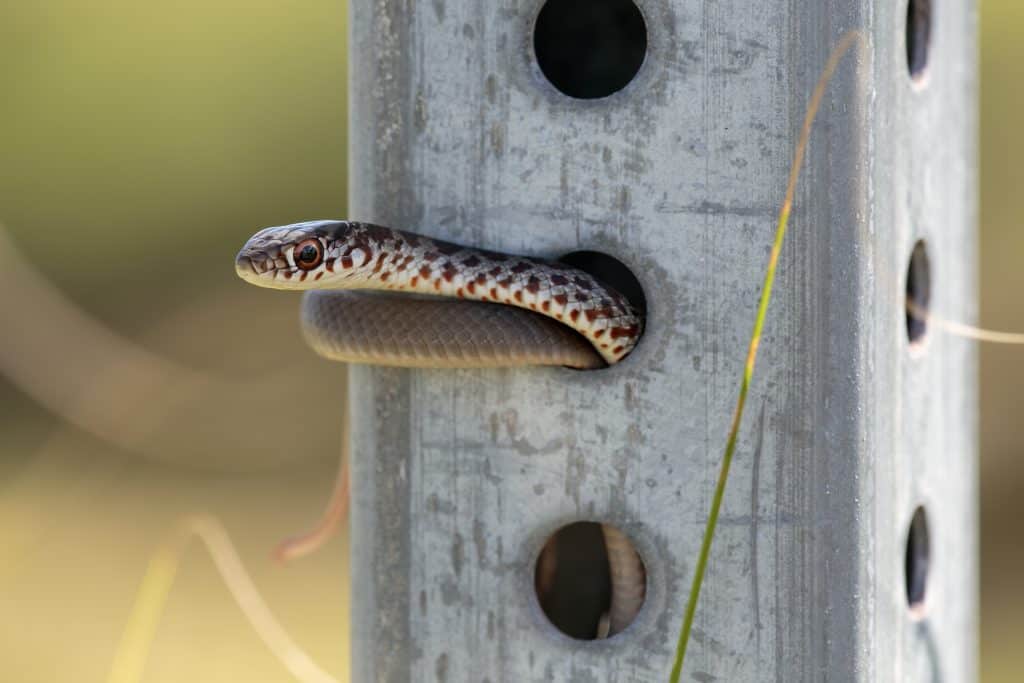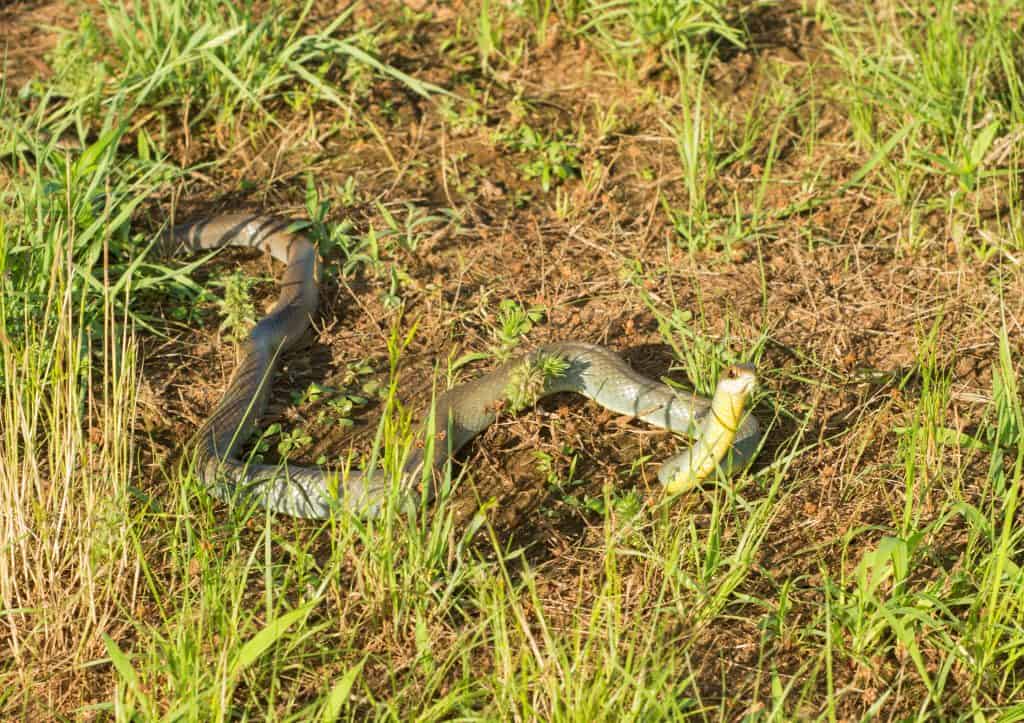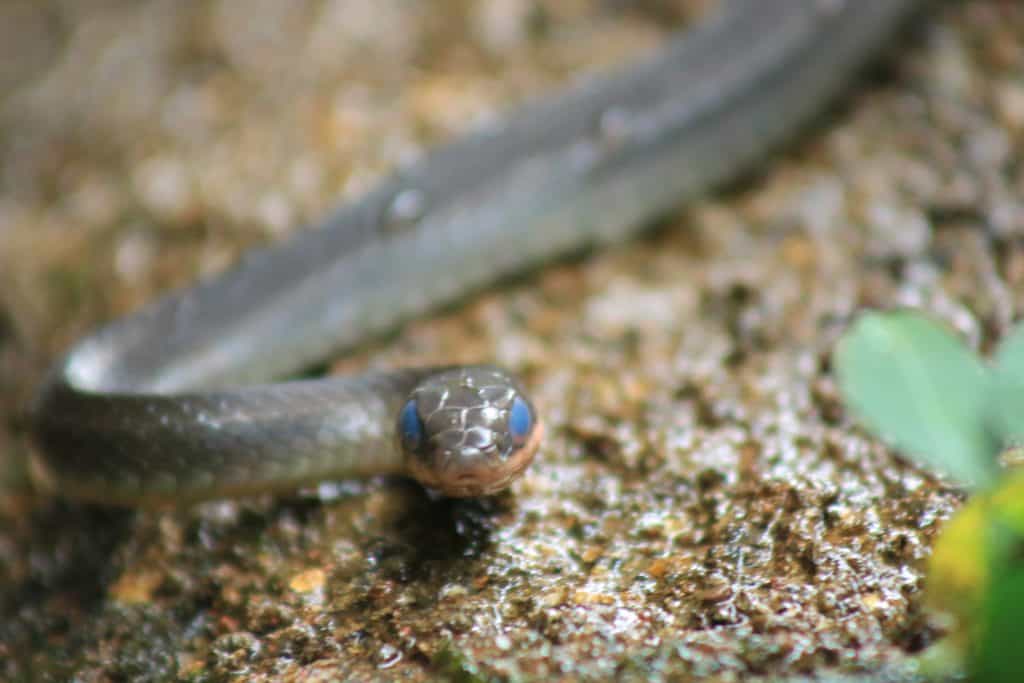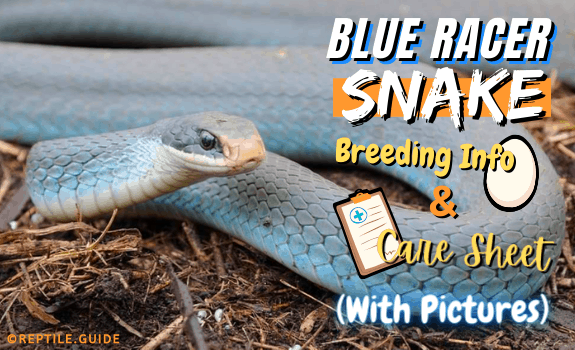The blue racer snake (scientific name Coluber constrictor foxii) is a subspecies of North American non-venomous constrictors known as racers (Coluber constrictor).
Their striking colors pique the interest of reptile lovers, but their high-strung attitude makes them less-than-ideal for captivity. Due to the habitat loss they’ve been experiencing, they’re becoming increasingly hard to find in their native habitat.
This species is likely best observed and admired in its native habitat. Keep reading to learn where to find them, what they do, and more!
(Cover picture by NCC)
In This Article
Facts at a Glance
|
Common Name |
Blue Racer |
|
Scientific Name |
Coluber constrictor foxii |
|
Adult Size |
3-5 Feet (Up to 1.5 meters) |
|
Native Range |
the Midwestern United States and a small population on Pelee Island, Ontario, Canada |
|
Lifespan |
10+ Years (read “Snake Lifespan Explained” to learn more) |
|
Natural Diet |
Insects, rodents, birds, frogs, and other reptiles |
|
Natural Habitat |
Open woodlands, shorelines, and edge habitats |
|
Do They Make Good Pets? |
No |
|
Minimum Enclosure Dimensions |
72″ x 18″ x 19″ (L x W x H) |
|
Temperature |
70-85℉ |
|
Humidity |
50% |
Blue Racer Snake Size and Appearance
Average Size: 3-5 Feet
The blue racer is a thinly-built snake that reaches an SVL (snout-to-vent length) of up to 60 inches. That doesn’t even include their tail, which can sometimes push their size to over six feet! They’re the largest snakes in most of their native range.
Blue racer’s smooth scales range from white to black and even blue. The vibrant coloration is most often visible on their sides.
An adult blue racer’s belly and chin are usually light gray, white, or cream-colored. On their sides, the scales are vibrant and metallic – ranging from silver to electric blue. Those scales fade to black or dark gray towards the animal’s top dorsal region.
Hatchlings are easy to misidentify as an entirely different species. They’re typically bluish-gray with brown dorsal blotches. Rest assured, these babies are still Coluber constrictor foxii!

Blue racer snakes have large, round eyes – a testament to their excellent vision. A black band extends from their eye back to their neck on both sides.
Blue Racer Native Range and Habitat
In the United States, the blue racer is endemic to a portion of the Midwest, including:
- Iowa
- Ohio
- Illinois
- Oregon
- Indiana
- Kentucky
- Michigan
- Wisconsin
- Washington
- South Dakota
While most areas have seen population declines, populations in northern Michigan are thriving and even expanding!
In Canada, an isolated small population lives on Pelee Island in southwestern Ontario. The last record of a blue racer in mainland Canada was in 1983.
Savanna, fields, lake shorelines, and open woodlands are prime habitats for blue racers. They prefer open and semi-open environments that offer quick access to cover, like animal burrows or vegetation.

Their territories range from two and a half acres to 25 acres, depending on resource availability. The area usually overlaps various habitats, like an open forest and an adjacent shoreline.
One major consistency is that blue racers do NOT thrive in areas with excessive human activity. When new development occurs, they’re among the first species to vacate the area.
Habitat loss due to human encroachment is the biggest reason for their population decline.
Conservation
IUCN Red List Status: Not yet assessed (believed to be endangered)
Some regions, such as Wisconsin, independently list the blue racer snake as an endangered species. Blue racers are also listed as an endangered species to protect their limited habitat on Pelee Island in southwestern Ontario, where they’ve been subject to significant habitat loss.
Human persecution, habitat loss, and road mortality are the primary reasons for their population decline in inhabited, unprotected areas.
Blue Racer Temperament and Behavior
Blue racers are diurnal, meaning that they’re active during the day. Their large eyes and round pupils are perfectly adapted for visually hunting in daylight.
Blue racers particularly enjoy basking in direct sunlight, as long as there is nearby cover to “race” into. Their excellent eyesight allows them to detect potential threats from a distance.
A blue racer’s first instinct is always to flee, and they’re pretty good at escaping. When flight doesn’t work, this species is quick to switch into fight mode.
Biting and Self-Defense
When cornered, blue racers are known for their defensive attitude. Their first warning sign is a tail rattle that creates a buzzing sound, like the rattle of a rattlesnake.
If you ignore the buzzing sound and you’re fast enough to capture a blue racer, it will not hesitate to bite you. It may also musk on you.
Snakes release musk from their cloacal scent gland as a means of self-defense. It smells terrible and is difficult to wash off.
Luckily, blue racers are non-venomous, and their musk isn’t more than an inconvenience. Even their bite doesn’t hurt more than a cat scratch.
Speed
Top Speed: 4 Miles per Hour (6 Kilometers per Hour)
This speed is roughly equivalent to your brisk walk. While it may not sound impressive, they’re the fastest snakes in their native range.
Diet
Scientists have confirmed that blue racers will consume an incredibly varied, opportunistic diet.
Hatchling blue racers consume invertebrates, such as:
- Moths
- Spiders
- Locusts
- Crickets
- Butterflies
- Millipedes
- Grasshoppers
Juvenile and adult blue racers have much more opportunistic and varied diet, including:
- Mice
- Frogs
- Voles
- Toads
- Shrews
- Lizards
- Songbirds
- Other birds
- Other snakes
- Nesting bird eggs
- Other small mammals
Although terrestrial, blue racer snakes will also hunt for prey high up in the vegetation of open woodlands. They’re known nest-raiders.
Despite their scientific name, Coluber constrictor, blue racer snakes don’t constrict their prey. They hold the critter still in their coils and swallow the animal whole and usually live.
Brumation
Brumation Period: October – April
Blue racer snakes brumate communally with other species, particularly eastern fox snakes (scientific name Pantherophis gloydi). These hibernation groups can include over 100 snakes.
They generally hunker down in animal burrows, rocky crevices, and other insulated shelters.
When they emerge from their winter dormancy in April, it’s time to pair up and find a mate(s)!
Reproduction
Minimum Reproductive Age (Males): 11 Months
Minimum Reproductive Age (Females): 24 Months
Average Clutch Size: 15 Eggs
Blue racer snakes begin mating in April and continue through May. Females likely reproduce every other year, although they’re capable of reproducing annually.
After successfully mating, females lay their clutch in late June. Common nest sites include rotting logs, large rocks, and mounds of organic compost.
Similar to group hibernation, scientists have documented blue racers laying in communal nest sites with other snakes, including other species – primarily eastern fox snakes.
After incubating for two to three months, the eggs hatch from mid-August to late September.
Significance in the Ecosystem
Blue racers of all ages assist in population control of insects and mammalian pests.
They’re also an important food source for birds of prey, raccoons, foxes, and coyotes.
Blue Racer Husbandry
Do Blue Racer Snakes Make Good Pets?
Generally speaking, blue racer snakes do not make good pets.
Here are some reasons to reconsider keeping a blue racer as a pet:
- Blue racer snakes are active and flighty. They require a much larger enclosure than ambush predators, like ball pythons.
- Their high-strung nature makes them difficult to tame and susceptible to injuring themselves when trying to escape or deter a perceived threat (you).
- While they’re opportunistic hunters in the wild, blue racers seem to develop a pickier appetite under the stresses of captivity. It’s challenging to get them to eat.
- While it’s not proven that they require UVB exposure, wild blue racer snakes are frequent baskers. Therefore, it would be inhumane to deny them access to overhead heat and UV in captivity.
Where to Buy Blue Racers
Since blue racer snakes aren’t well-suited for captivity, most animals on the market are wild-caught. Wild-caught animals can be difficult to acclimate to captivity.
Due to declining populations, we strongly advise against purchasing a wild-caught blue racer.
Your best bet is to find a dedicated snake breeder that’s working on this snake species. Reptile expos, networking, and online forums may be able to point you in the right direction.
Supply List
- Large enclosure
- At least two hides
- Suitable substrate
- UVB lamp and bulb
- Medium-sized water dish
- Heat lamp and bulb with thermostat
- A steady supply of live feeders (insects, rodents, reptiles, and birds)
Enclosure Size and Style
Minimum Adult Enclosure Size: 72″ x 18″ x 19″ (L x W x H)
Blue racers are active foragers who need a large habitat. Given that their wild territory is at least two and a half acres, we recommend giving them as large of an enclosure as possible.
Floor space (length by width) is the primary dimension you should consider. While they’re perfectly capable of climbing, blue racers are most comfortable on the ground.
You also need to ensure that the enclosure is tall enough to keep the UVB light a safe distance from the basking spot. For most UVB lamp models, this is at least 18″ of distance from the surface.
Most reptile keepers prefer glass enclosures, like aquariums. While they’re convenient and readily available, they may feel too open for your blue racer.
Blue racers have excellent eyesight. It’s best to block off most of the habitat walls. With its extraordinary vision, a blue racer snake may believe it can travel through a transparent wall. This situation will lead to stress and injuries.
PVC enclosures are perfect because they usually only have one clear side – the front. They’re also great at holding heat. Just be sure there are plenty of ventilation openings.
Lighting
Ideal Light Cycle: 12 Hours Light / 12 Hours Dark
For such an active, diurnal species, an appropriate day and night cycle is imperative.
In the Summer, you may increase daylight hours up to 15 hours per day.
In the Winter, as long as you’re lowering the temperature to promote brumation, you can eliminate any lighting. A wild, hibernating blue racer snake would remain hidden in total darkness until Spring.
You should provide UVA and UVB light since this species frequently basks in the wild. While your snake may survive without UVB, it certainly wouldn’t thrive.
Scientists have already proven the benefits of UVB exposure for many captive snake species.
Heating
Basking Spot Temperature: 80-85℉
Warm Side Temperature: 75-80℉
Cool Side Temperature: 70-75℉
Nighttime Temperature: 68-72℉
An incandescent lightbulb is the best daytime heat source for a blue racer.
Be sure to run the heat lamp on a dimmer or a dimming thermostat. The constant on and off action of a cheap thermostat will shorten the life of any lightbulb. It would also be stressful for your snake – the sun doesn’t flicker on and off throughout the day.
At night, turn the light off and let your blue racer’s habitat reach room temperature. Never use a “nighttime heat lamp,” like a red bulb or a blue bulb.
Snakes are capable of seeing these colors. On top of disrupting your snake’s day and night cycle, it may damage his vision.
Water and Humidity
Ideal Humidity: 40-60%
Your blue racer should have constant access to fresh water. It’s best to use a wide, shallow dish that can aid in maintaining humidity and allow your snake to soak or swim.
Change out the water every day.
Wash and scrub the water dish at least once a week or whenever it’s soiled.

Snakes benefit from a higher humidity level when they’re in shed. You can increase the humidity by adding water to the substrate or misting the surfaces of the habitat. Here are some telltale signs that a snake is in shed:
- Milky blue eyes
- Faded markings
- Darkened colors
- Increased grayness
- Remaining hidden for longer than normal
Decor and Environmental Enrichment
Blue racer snakes are an active and curious species. In the wild, scientists have observed them hunting in grasslands, treetops, and even aquatic habitats.
Equipping your blue racer’s habitat with various climbing opportunities, hiding opportunities, novel textures, and a large water dish is the best way to encourage natural behaviors. Try to replicate their preferred open forest habitats.
Active snakes are healthy snakes! Do you need some ideas to get you started?
- Caves
- Vines
- Rocks
- Branches
- Hollowed logs
- Reptile waterfalls
- Plants, live or fake
- Bird toys, i.e., ladders and ropes
Substrate
Good:
- Newspaper
- Paper towels
- Coconut husk
- Coconut fiber
- Cypress mulch
- Aspen shavings
- DIY organic topsoil and playsand mix
Bad:
- Sand
- Pine or cedar
- Reptile carpet
Cohabitation
There’s limited information about keeping this species in captivity.
Since they nest and hibernate communally in the wild, it may be possible to cohabitate similar-sized blue racer snakes together.
Never try housing other snake species with your blue racer since they’re known snake-eaters.
There’s still a risk that two blue racers may fight or even try to eat each other. Observe them for signs of stress or injuries daily. Never house snakes of significantly different sizes together.
Blue Racer Diet and Feeding Guidelines
Captive Food Options
There are many feeder animal species in captivity that can help you replicate the varied diet of a wild blue racer. Since these snakes are visually-oriented hunters, offer prey that’s alive and moving.
Try to include as many of these species as your snake will accept:
- Rats
- Mice
- Quail
- Frogs
- Anoles
- Gerbils
- Rabbits
- Crickets
- Quail eggs
- Other small mammals
- Other birds and bird eggs
Amount
Blue racers are an active snake species with a fast metabolism.
Still, it’s typically best to feed one appropriately-sized prey item per feeding.
Choose a size or age of prey that’s roughly as wide or slightly less wide than the widest part of your snake’s body.
Frequency
Hatchlings and Juveniles: Every 2-3 days
Adults: Every 5-7 days
Techniques
It’s important to note that your blue racer is a sight-based hunting species. They’re more attracted to movement than they are to scent or body heat.
Therefore, it’s unlikely that you’ll ever switch your snake to frozen and thawed prey.
The safest way to feed live prey is with constant supervision and a healthy dose of caution. For example, a young rabbit with its eyes still closed has less ability to injure your snake than a fully-grown mouse.
Supplements
Supplements aren’t usually necessary for captive snakes.
A diet consisting of solely live prey also makes supplementation difficult.
You could attempt dusting live feeders’ fur or feathers with a reptile multivitamin. Observe your snake’s response – if it makes your pet refuse his food, it’s not worth the hassle.
Always coat feeder insects with calcium powder that doesn’t contain added Vitamin D3.
As long as you’re providing the recommended UVB lighting for this basking species, it will synthesize all of the Vitamin D that it needs. Excessive dietary Vitamin D3 supplementation can lead to overdose and toxicity.
Blue Racer Handling and Bonding Tips
For the most part, you should avoid handling your blue racer unless it’s necessary.
Blue racers are a flighty and nervous species. Stress-related injuries are a cause for concern:
- Drops and falls as a result of suddenly bolting without warning
- Infections from teeth that may break or get stuck in your skin after a bite
- Nose rub and abrasions from hitting enclosure walls in an attempt to strike or flee
- Spinal injuries from whipping their tail around while you attempt to restrain them
- If you need to move your snake for cage maintenance or a veterinary trip, follow its cues. If the snake seems stressed or flighty, restrain it so that it doesn’t injure itself in an attempt to escape.
As long as it’s moving calmly, you can attempt hand-over-hand handling, as is typical with most other snakes.
If it starts freaking out and whipping around, you’ll want to GENTLY restrain its body, starting by gripping behind the head. Restraint is used only to prevent the snake from injuring itself.
Blue Racer Health and Wellness
Signs of a Healthy Blue Racer Snake
- Active and alert
- Quiet breathing (may be rapid)
- Nostrils, vent, and mouth free of discharge
- No pieces of stuck skin or discolored scales
- Thin but well-muscled, spine and ribs are barely visible
Veterinary Care
Before you bring any snake home, we recommend researching the qualified veterinarians that live in your area.
The Association of Reptile and Amphibian Veterinarians has a handy “Find a Vet” tool for this purpose.
Most “regular” veterinarians won’t see reptile patients, especially an uncommon species like the blue racer.
Shedding
Shedding is a normal process for all reptiles. Shedding helps with growth, healing, and even communicating with other snakes.
All snakes, including the blue racer, should shed their skin off in one solid, tube-like piece. Flaky or broken sheds indicate dehydration and low humidity.
Blue racers will shed more often when they’re young. As adults, they probably shed four to eight times per year.
Signs of a Sick Blue Racer Snake
- Stuck shed
- Overly calm and placid
- Growths or discoloration on the scales
- Presence of ectoparasites (mites, ticks)
- Discharge from nostrils, vent, or mouth
- Noisy breathing (clicking, rattling, rasping, hissing, gurgling)
Injuries
The blue racer’s flighty nature leaves them prone to bumps, bruises, scrapes, and even broken bones.
To mitigate these risks, block off most of the enclosure’s walls and keep your blue racer in a quiet room. Limit handling it, and exercise an abundance of caution when you do.
Respiratory Infection
The most common ailment in captive snakes is a respiratory infection. The stress, poor airflow, and improper humidity levels of humidity are a lethal combination.
Symptoms of a respiratory infection include noisy breathing, open-mouth breathing, and discharge from the nose or mouth. Your reptile veterinarian will prescribe antibiotics to treat the infection.
External Parasites
External parasites are easy to identify.
Ticks are familiar to most people. They start as flat, disc-shaped critters. Once they attach themselves and begin eating, their body inflates with blood until they’re round.
You can removed and discard ticks on your own or seek a veterinary professional for assistance.
Mites are trickier. They will infest your reptile’s home, similar to fleas with dogs and cats.
You’ll need to clean and treat or replace everything that has ever come into contact with your snake, possibly including the snake itself. Over-the-counter mite treatments are readily available.
More North American Constrictors
Truthfully, as pretty as they are, blue racers are too difficult for most beginner and even intermediate reptile keepers.
If you’re interested in an easier North American colubrid species, check out the corn snake.
Alternatively, if the blue color has drawn you in, consider the Florida blue-striped garter snake, Thamnophis sirtalis similis.
There are thousands of snake species in virtually every color of the rainbow. Comment below to let us know what colored species you’d like to learn about next!
